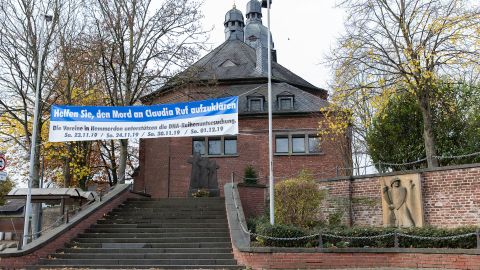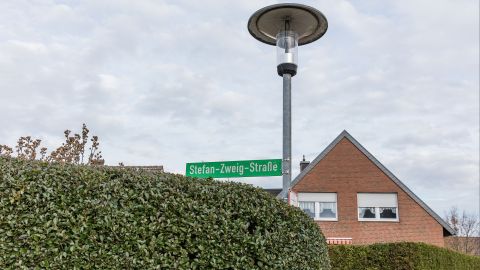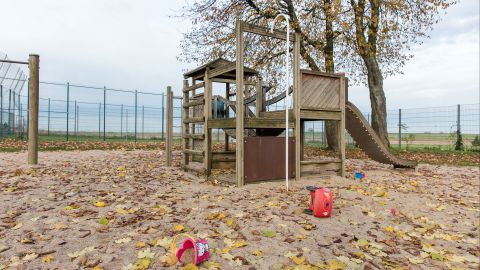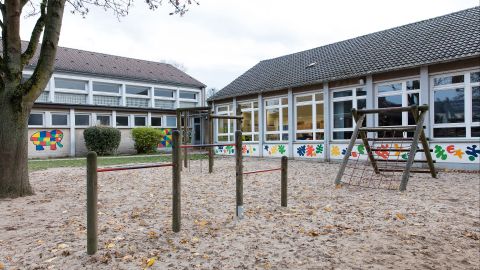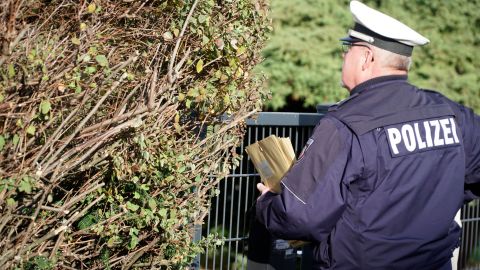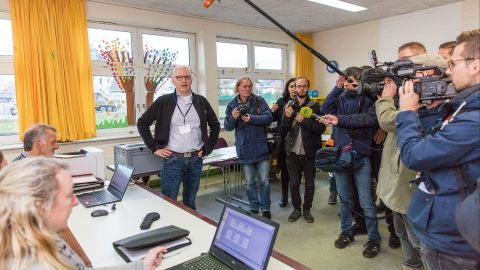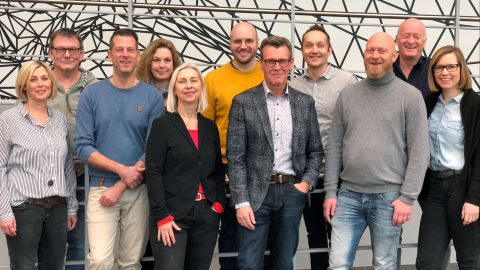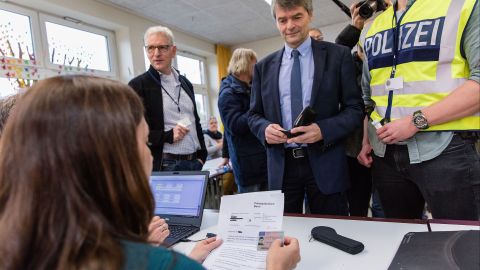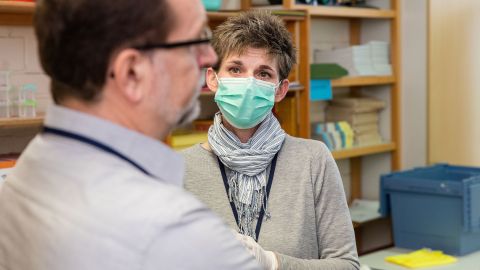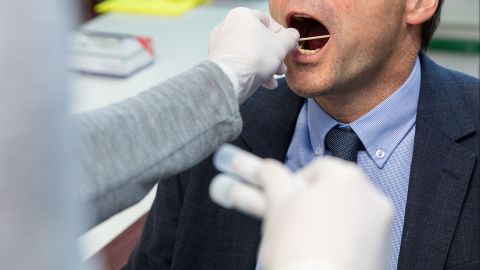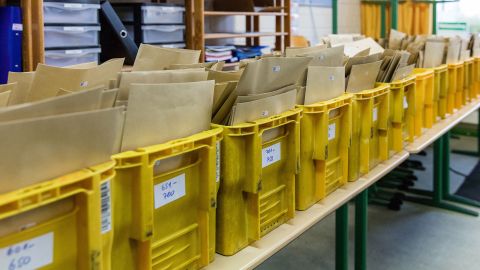Hemmerden never forgets. Around 2,500 people live in the small village in the town of Grevenbroich in the Rhine district of Neuss. And even though the murder of eleven-year-old Claudia Ruf took place 24 years ago, in the days leading up to Christmas last year it seemed as if it had only just happened. In front of the church, the men from the local history association decorate the square with fir branches and hang up fairy lights. It's actually just another Saturday in the run-up to Christmas, if it weren't for the cameras set up by reporters. If a crowd hadn't formed in front of the elementary school, mostly middle-aged men carrying a letter from the police. An invitation to take a serial DNA test.
1,900 people are invited to give their saliva sample
Men who were between 14 and 70 years old in 1996. For the first time in Germany, a method is being used here in Hemmerden that also makes "DNA close matches" up to the third degree of kinship possible. The legal basis is an amendment to the Code of Criminal Procedure. For the investigators, this means a new approach. Hope for the people of Hemmerden. And for the relatives of Claudia Ruf?
In a video, the girl's father addressed the public for the first time since his daughter disappeared. "It can't be that someone simply kills a child and ultimately destroys a family. I'm not interested in revenge - I'm interested in justice," he said in the video, which was broadcast by WDR. Friedhelm Ruf appealed to take part in the investigation, saying he needed certainty.
Even then, he would probably not be able to put an end to it, but "of course you want to know what happened. Because Claudia would be over 30 today, I might already be a grandpa. And that has all been destroyed," said Ruf. Officers from the State Office of Criminal Investigation accompanied him to the recording of the television appeal, as moral support, he said. In the years since the murder, contact between the police and Friedhelm Ruf has never been broken off. The investigators are talking about a very last chance, and they want to make the most of it. Despite the great effort, despite the work that such a case entails, this new opportunity also releases new energy. This can be felt by everyone involved, especially the police officers, those who are new to the case and, of course, even more so those who have not let go of the girl's death for years.
The "operational case analysis" at the State Office of Criminal Investigation (LKA)
Andreas Müller, Head of Operational Case Analysis at the State Criminal Police Office, for example: Müller and his team reassessed, analyzed and examined the murder case and ultimately came to the conclusion that the new legal and technical possibilities justify the expense of a mass genetic test. Müller is a sober analyst, patient, conscientious and unpretentious. The numerous reporters who have covered the Claudia Ruf case these days would have liked to turn it into a personal story: Müller, the dogged investigator who can't let go of this case, the country's "chief profiler" on his own personal mission, something like that. It makes sense to tell this case in this way, as Müller was one of the police officers who was in that field near Euskirchen after a jogger found the body of eleven-year-old Claudia two days after she disappeared. But reality is not a crime novel.
Talking to Müller about the Claudia Ruf case and the operational case analysis at the LKA is all about methodology, probabilities and scientific approaches. Müller sees himself and his nine-strong team as consultants. "You need a certain distance to do this work," he says. The fact that he was working in the Bonn police homicide squad at the time when they failed to find Claudia Ruf's murderer and rapist is no longer relevant today.
Review
Times were different back then. The investigation began with the search for Claudia on 11 May 1996. The eleven-year-old had not returned from a walk with a neighbor's dog at around 6 pm. The dog had found its way home alone at around 6.50 p.m. and was distraught, as if it had been mistreated, according to the investigators. More than 100 police officers searched the surrounding fields and woods in Hemmerden for the girl. Claudia's parents, neighbors and many other Hemmerden residents took part in the operation, which lasted well into the night. When there was still no sign of Claudia early the next morning, the police were called in. But Claudia remained missing. Finally, on May 13, the child's body was discovered in a field near Euskirchen-Oberwichterich. The perpetrator had doused her with petrol and set her on fire. The area around the discovery site was then searched for evidence. The public was also kept up to date on the murder case.
Information from the public kept coming in. More and more information, more and more clues, which the investigators followed up. They dressed a mannequin in the clothes the girl was wearing at the time of the abduction. A photo was attached to the mannequin's head. The pictures were published in the newspapers, posters were hung in front of public buildings, on buses and trains. Leaflets appeared in weekly newspapers and police officers went from house to house distributing them. For the first time, the police set up a website about the case. In July 1997, the case was presented on "Aktenzeichen xy... ungelöst". There were more clues, and in the end the "Claudia Ruf" file had 140,000 pages in 96 folders. No progress was made, the case went cold. A "cold case" that no longer offered any investigative leads.
And yet the investigation continued. "Over the years, we have always tried to improve the leads. We finally succeeded in 2008 when we found DNA relevant to the crime on Claudia's body for the first time," says Reinhold Jordan, head of the Bonn homicide squad. The investigators were also electrified back then. 350 people whose names appear in the files were asked to provide a saliva sample. But there was no match. Nine years later, all persons who lived in the greater Euskirchen and Grevenbroich area and who had appeared as sex offenders were tested again by means of a DNA series examination order. This involved 120 people who provided a saliva sample, but this investigation also came up negative.
Current investigative work
"We have now managed to aim for a new DNA serial investigation thanks to further refined methods in DNA testing. We are now looking for a local perpetrator in the Grevenbroich-Hemmerden area," says Jordan. He and the operational case analysis specialists at the LKA led by Andreas Müller are certain that the perpetrator comes from Hemmerden or had a strong connection to the town. "It's conceivable that Claudia met the perpetrator on her walk, passed his house and the perpetrator may have lured her in with a treat for the dog. The perpetrator may also have taken her to a nearby room and killed her there that same evening," says Jordan. The new serial investigation is based on paragraph 81h of the Code of Criminal Procedure. The prerequisites for this are that it must be a serious crime.
"Then we have to define examination characteristics, which in this case are based on the results and the new findings of the operational case analysis by the State Criminal Police Office. This can, for example, relate to the gender of the perpetrator or their age or a local connection to the crime scene or 'other'," says senior public prosecutor Carola Guddat. By means of a dragnet search based on sections 98 a and b of the Code of Criminal Procedure, the persons to be checked are determined using data from various authorities. They are then invited to provide a saliva sample. The DNA samples are compared with the traces that have been recovered.
"It is now the case that male DNA from Claudia's body has been isolated and typed. From a forensic point of view, this DNA can be classified as relevant to the crime," says DNA expert Dirk Porstendörfer from the LKA. The amendment to Section 81h of the German Code of Criminal Procedure now not only makes it possible to directly match a person with a trace for identity, but it is now also possible to determine "whether this person has a close genetic relationship to the unknown tracer", says Porstendörfer.
"Cold case": murder is not time-barred
For the "cold case" unit at the LKA, this is nothing less than a quantum leap, says Andreas Müller. The principle that "murder is not time-barred" takes on a whole new force with this new possibility. The Claudia Ruf case is just the beginning of a whole series of cases in which investigations have come to a standstill and which have now been resumed and could possibly be solved. The unit at the LKA was launched in 2017 with the primary aim of creating a database of unsolved homicides from 1970 to 2015. 1,105 unsolved homicides have been identified so far during this period. These should be examined to see whether they are worth reopening, particularly in the area of outstanding or more modern forensic investigation methods. The identified investigative approaches are successively reported back to the criminal investigation departments in a standardized letter. The cases are categorized according to the type of available investigative approaches and prioritized according to the chances of clarification, resources required, publicity effect and limitation periods.
Of the 484 identified cold cases from the period 1990 to 2015 (phase 1), 318 cases have so far been made available by the main criminal investigation departments. A further 84 cases were rejected for various reasons or could no longer be made available because the crime had been solved in the meantime.
Of these 318 cases, 181 cases have so far been transferred to the database after quality checks by the operational case analysis. 174 cases were checked for possible investigative approaches, categorized and prioritized. In 89 "cold cases" (51.14 percent), investigative and forensic investigation approaches were identified that could lead to the clarification of the previously unsolved homicides. The murder of Claudia Ruf is just one of these cases.
Mass gene test in Hemmerden
The crowd at Hemmerden elementary school was huge. Around 1,000 men who fall into the grid gave their saliva sample. A total of around 1,300 samples have now been sent to the LKA for analysis. Around 600 samples are still outstanding. From men who have died since 1996, who have moved away or who did not accept the invitation. They are now the focus of the investigation. "The men who did not attend the appointments at the elementary school despite being invited are being visited by the officers. Men who now live elsewhere in Germany or abroad will be contacted via the local police authorities or the homicide squad's investigation teams and asked to provide a saliva sample on site. We will also visit the relatives of the deceased," says Jordan, explaining the next steps. It is not unusual that the match has not yet been found. Patience is needed in the Claudia Ruf case.
One result is already clear, however: the police have received a great deal of support from the public in recent weeks, which has also been due to the transparency and dedication of the officers. For example, police officers have been out and about in the town distributing brochures. The LKA produced a film that explained to people exactly what would happen to their sample and made it clear, for example, that it would only be used for this case. A mobile police station was set up on the church square, where people in Hemmerden could turn to with their questions. The press, radio and television were informed in advance and kept constantly up to date. We know that we are reopening old wounds here, but we wouldn't do it if we didn't see the chance to clear up this case after all, they said. And people trusted the authorities.
A few days before the action, an initiative was formed by the Hemmerden associations. How can we motivate people to support the police in their efforts, the people asked themselves, how can we make it possible for this crime to be solved after all? They decided to hang a large banner on the church to shake people up, to remind them that something terrible had happened here, something that had changed this place. Something that has not been solved, that has not been atoned for, that still lies in the dark. A child was murdered. The police are investigating again. There is a chance. For Hemmerden and for the investigators, and it must be seized.
